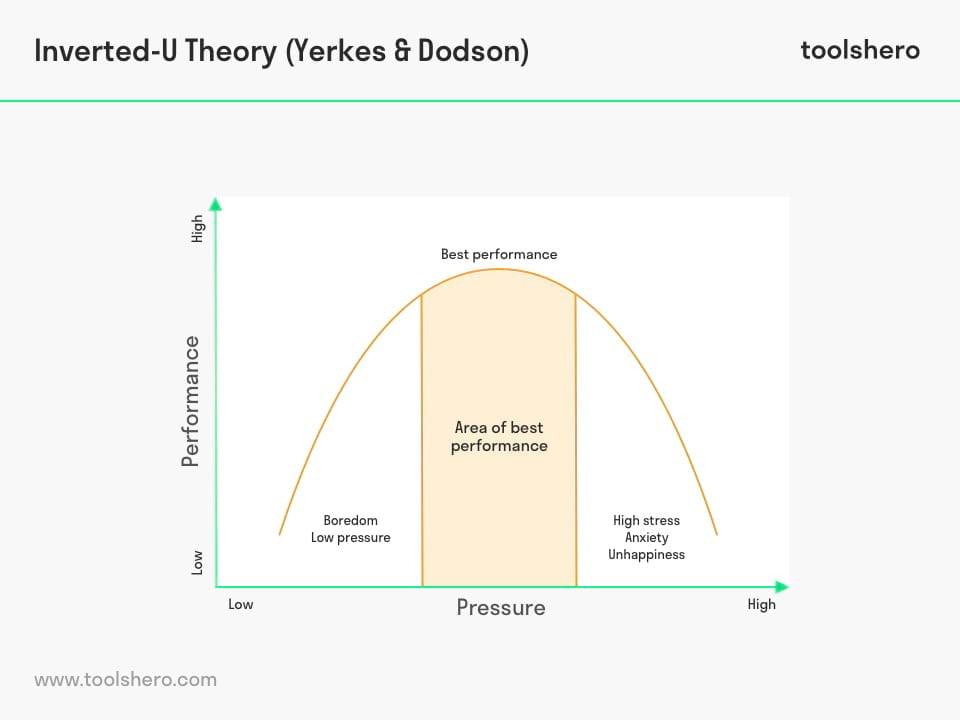Inverted-U Theory of Stress (Yerkes & Dodson)

Inverted-U Theory: this article explains Inverted-U Theory, developed by Robert Yerkes and John Dodson in a practical way. Next to what it is, this article also highlights the interpreting of the model, the four influencing factors and responding to stress and pressure. After reading, you’ll understand the basics of this stress management theory. Enjoy reading!
What is Inverted-U Theory?
Inverted-U Theory is a theory that sheds light on the relation between performance and pressure or arousal. In the original study, rats were given electric shocks as motivation for escaping from a maze.
The Inverted-U Theory owes its name to the line, in the form of an inverted U, that appears when there is a correlation between pressure and performance. This is illustrated in the graph presented in this article.

Figure 1 – the nverted-U theory model
A quick look at the curve reveals that performance lags behind when there’s little pressure, and that performance is positively influenced when there’s some more pressure.
If even more pressure is added, performance is negatively influenced and efficiency decreases. The worker’s efficiency and performance can reach an optimal point if the pressure or arousal have reached an optimal point.
Inverted-U Theory was developed by psychologists Robert Yerkes and John Dodson in 1908. Despite the fact that the model was developed long ago, it continues to be relevant.
Interpreting the Model
When looking at the left-hand side of the graph, it’s notable that low pressure or low stress levels result in a stress response corresponding to ‘boredom or lack of challenge’.
Even if the task itself is a critical activity, the attention, concentration, and precision required to properly execute a task is absent in the absence of an appropriate level of pressure or stress.
On the right-hand side of the graph from the Inverted-U Theory, we can see that extreme pressure levels or high stress levels don’t automatically result in good performance.
The opposite is true: if pressure gets too high, or a too high stress level is activated, this results in a feeling of unhappiness, stressfulness, and anxiety. These are all results of overwhelming stress.
In the middle of the graph, however, is a region where the worker performs best. This area is where an optimal amount of pressure is applied. In this region, the moderate pressure leads to an optimal stress level, which is manageable as well. Eventually, this results in the highest performance level for the user.
The optimal level of pressure or arousal is influenced by a number of factors.
Four Influencing Factors of the Inverted-U Theory
It can be hard to determine how much impact pressure, and stress have because the desired amount of pressure is influenced by four factors. These factors are also known as influencers. Inverted-U Theory recognises the following four influencers:
Personality
Different personality types benefit from different levels of stress or pressure.
Generally, extraverted personalities are more resistant to stress and better able to keep their head above water when stressed than introverted personalities. Introverted people usually have a higher chance of performing well in environments with little stress or excitement.
There are also factors, of course, that can cause temporary pressure or stress. These may be professional matters or matters in private life. The duration of the period in which stress or pressure are present may differ as well.
Task Difficulty
The degree of complexity of a task relates to the level of attention and effort a person requires to successfully complete it. People are generally able to carry out simple activities even when pressure is high, but complex tasks are better taken care of in quiet surroundings.
Skills
A shop manager and an accountant have completely different jobs. Each has more knowledge of the work they do individually than of the other’s job.
If they would swap jobs, the challenge and the pressure would be so high in the beginning that it would strongly motivate them. After a while, when tasks get easier, they would have to use a new form of pressure to keep their performance up.
Fear
Inverted-U Theory shows that fear can also have an effect on performance. This mainly relates to the ability to set aside or ignore feelings of fear in order to be able to keep one’s focus on the situation and the tasks.
People who are better at this also perform better under pressure. People who are not good at it will enter into challenging situations more often.
Complexity and Motivation
In situations that require carrying out tasks with a high level of complexity, or solving complex problems, motivation plays an important role.
There have been various situations in which the relation between motivation and complex problem solving was studied. These have yielded several theories, such as McClelland’s motivation theory and Maslow’s hierarchy of needs.
Stress Management: 40+ easy ways to deal with stress
Stress relief and burnout prevention. Don’t let stress control your life. Beat anxiety and worries. Live, Laugh, Love.
Inverted-U Theory: difference between pressure and stress
The terms ‘pressure’ and ‘stress’ are often used interchangeably, as if they refer to the same thing. ‘I work in a high-pressure environment’, or ‘I have a stressful job’. According to science, however, there definitely is a difference between pressure and stress. These two things reappear regularly in Inverted-U Theory.
‘Stress’ refers to situations that demand a lot from someone who has few resources such as money, time, energy, or manpower.
Pressure, on the other hand, is a situation in which someone notices that there are extensive consequences to the outcome of a certain action. It’s the feeling that something is at stake, depending on one’s performance. Stress can create several problems that can lead to feelings of overload and, in the most extreme case, even a occupational burnout.
Stress on the job is caused by things such as late meetings, long lists of emails that have to be answered, approaching deadlines, or emergency situations.
Pressure often becomes apparent from signals such as anxiety and the feeling that a situation is life-or-death.
A job interview, too, is an example of a situation where one’s actions may have far-reaching consequences, which is why it is not described as a stressful situation.
Inverted-U Theory: responding to stress and pressure
Different stress levels or feelings of pressure cause different reactions and approaches in people. In an extraordinarily stressful situation, a person’s goal is to feel less overwhelmed. In a situation of pressure, the goal is to perform well.
There are various things that can be done to reduce stress. Going for a walk after a long day in the office is good for you, and spending time on hobbies on the weekend also lowers stress.
In a high-pressure situation, these same options are often unavailable. A special forces soldier who is involved in a rescue mission has no time to relax and settle down, but may have to react instinctively and adequately without changing their stress levels.
If the difference between pressure and stress is not understood, a person will be at a higher risk to label any situation as a pressure situation. This may lead to a lot of pressure. That feeling may eventually lead to people feeling as though they are being held at gunpoint.
Now It’s Your Turn
What do you think? Do you recognise the explanation about Inverted-U Theory? What do you think are important points when it comes to using this tool? How do you experience the influence of pressure on your performance? Are you facing excessive stress, or rather little or no pressure? Do you have any tips or additional comments?
Share your experience and knowledge in the comments box below.
More information
- Broadhurst, P. L. (1957). Emotionality and the Yerkes-Dodson law. Journal of experimental psychology, 54(5), 345.
- Broadhurst, P. L. (1959). The interaction of task difficulty and motivation: The Yerkes Dodson law revived. Acta Psychologica, Amsterdam.
- Cohen, R. A. (2011). Yerkes–Dodson Law. Encyclopedia of clinical neuropsychology, 2737-2738.
- Teigen, K. H. (1994). Yerkes-Dodson: A law for all seasons. Theory & Psychology, 4(4), 525-547.
How to cite this article:
Janse, B. (2019). Inverted-U Theory of Stress (Yerkes & Dodson). Retrieved [insert date] from Toolshero: https://www.toolshero.com/human-resources/inverted-u-theory/
Original publication date: 09/18/2019 | Last update: 12/25/2023
Add a link to this page on your website:
<a href=”https://www.toolshero.com/human-resources/inverted-u-theory/”>Toolshero: Inverted-U Theory of Stress (Yerkes & Dodson)</a>












